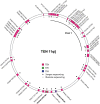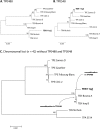Human Treponema pallidum 11q/j isolate belongs to subsp. endemicum but contains two loci with a sequence in TP0548 and TP0488 similar to subsp. pertenue and subsp. pallidum, respectively
- PMID: 28263990
- PMCID: PMC5354452
- DOI: 10.1371/journal.pntd.0005434
Human Treponema pallidum 11q/j isolate belongs to subsp. endemicum but contains two loci with a sequence in TP0548 and TP0488 similar to subsp. pertenue and subsp. pallidum, respectively
Abstract
Background: Treponema pallidum subsp. endemicum (TEN) is the causative agent of endemic syphilis (bejel). An unusual human TEN 11q/j isolate was obtained from a syphilis-like primary genital lesion from a patient that returned to France from Pakistan.
Methodology/principal findings: The TEN 11q/j isolate was characterized using nested PCR followed by Sanger sequencing and/or direct Illumina sequencing. Altogether, 44 chromosomal regions were analyzed. Overall, the 11q/j isolate clustered with TEN strains Bosnia A and Iraq B as expected from previous TEN classification of the 11q/j isolate. However, the 11q/j sequence in a 505 bp-long region at the TP0488 locus was similar to Treponema pallidum subsp. pallidum (TPA) strains, but not to TEN Bosnia A and Iraq B sequences, suggesting a recombination event at this locus. Similarly, the 11q/j sequence in a 613 bp-long region at the TP0548 locus was similar to Treponema pallidum subsp. pertenue (TPE) strains, but not to TEN sequences.
Conclusions/significance: A detailed analysis of two recombinant loci found in the 11q/j clinical isolate revealed that the recombination event occurred just once, in the TP0488, with the donor sequence originating from a TPA strain. Since TEN Bosnia A and Iraq B were found to contain TPA-like sequences at the TP0548 locus, the recombination at TP0548 took place in a treponeme that was an ancestor to both TEN Bosnia A and Iraq B. The sequence of 11q/j isolate in TP0548 represents an ancestral TEN sequence that is similar to yaws-causing treponemes. In addition to the importance of the 11q/j isolate for reconstruction of the TEN phylogeny, this case emphasizes the possible role of TEN strains in development of syphilis-like lesions.
Conflict of interest statement
The authors have declared that no competing interests exist.
Figures



Similar articles
-
Whole genome sequence of the Treponema pallidum subsp. endemicum strain Bosnia A: the genome is related to yaws treponemes but contains few loci similar to syphilis treponemes.PLoS Negl Trop Dis. 2014 Nov 6;8(11):e3261. doi: 10.1371/journal.pntd.0003261. eCollection 2014. PLoS Negl Trop Dis. 2014. PMID: 25375929 Free PMC article.
-
Whole genome sequence of the Treponema pallidum subsp. endemicum strain Iraq B: A subpopulation of bejel treponemes contains full-length tprF and tprG genes similar to those present in T. p. subsp. pertenue strains.PLoS One. 2020 Apr 1;15(4):e0230926. doi: 10.1371/journal.pone.0230926. eCollection 2020. PLoS One. 2020. PMID: 32236138 Free PMC article.
-
Syphilis-causing strains belong to separate SS14-like or Nichols-like groups as defined by multilocus analysis of 19 Treponema pallidum strains.Int J Med Microbiol. 2014 Jul;304(5-6):645-53. doi: 10.1016/j.ijmm.2014.04.007. Epub 2014 Apr 26. Int J Med Microbiol. 2014. PMID: 24841252
-
Genetic diversity in Treponema pallidum: implications for pathogenesis, evolution and molecular diagnostics of syphilis and yaws.Infect Genet Evol. 2012 Mar;12(2):191-202. doi: 10.1016/j.meegid.2011.12.001. Epub 2011 Dec 15. Infect Genet Evol. 2012. PMID: 22198325 Free PMC article. Review.
-
Genetics of human and animal uncultivable treponemal pathogens.Infect Genet Evol. 2018 Jul;61:92-107. doi: 10.1016/j.meegid.2018.03.015. Epub 2018 Mar 22. Infect Genet Evol. 2018. PMID: 29578082 Review.
Cited by
-
Development of a Multilocus Sequence Typing (MLST) scheme for Treponema pallidum subsp. pertenue: Application to yaws in Lihir Island, Papua New Guinea.PLoS Negl Trop Dis. 2017 Dec 27;11(12):e0006113. doi: 10.1371/journal.pntd.0006113. eCollection 2017 Dec. PLoS Negl Trop Dis. 2017. PMID: 29281641 Free PMC article.
-
Insights into Treponema pallidum genomics from modern and ancient genomes using a novel mapping strategy.BMC Biol. 2025 Jan 8;23(1):7. doi: 10.1186/s12915-024-02108-4. BMC Biol. 2025. PMID: 39780098 Free PMC article.
-
A retrospective study on nested PCR detection of syphilis treponemes in clinical samples: PCR detection contributes to the diagnosis of syphilis in patients with seronegative and serodiscrepant results.PLoS One. 2020 Aug 20;15(8):e0237949. doi: 10.1371/journal.pone.0237949. eCollection 2020. PLoS One. 2020. PMID: 32817658 Free PMC article.
-
Whole-genome sequencing reveals evidence for inter-species transmission of the yaws bacterium among nonhuman primates in Tanzania.PLoS Negl Trop Dis. 2025 Feb 26;19(2):e0012887. doi: 10.1371/journal.pntd.0012887. eCollection 2025 Feb. PLoS Negl Trop Dis. 2025. PMID: 40009604 Free PMC article.
-
Treponema pallidum genome sequencing from six continents reveals variability in vaccine candidate genes and dominance of Nichols clade strains in Madagascar.PLoS Negl Trop Dis. 2021 Dec 22;15(12):e0010063. doi: 10.1371/journal.pntd.0010063. eCollection 2021 Dec. PLoS Negl Trop Dis. 2021. PMID: 34936652 Free PMC article.
References
-
- Vabres P, Roose B, Berdah S, Fraitag S, Prost YD. Bejel: an unusual cause of stomatitis in the child. Ann Dermatol Venereol. 1999;126(1): 49–50. - PubMed
Publication types
MeSH terms
LinkOut - more resources
Full Text Sources
Other Literature Sources
Medical
Molecular Biology Databases

